
Lainie Fefferman
WALO
Lainie’s Portrait Project:
WALO was one of the first pieces I created for my portrait pieces project.
For this project I’m interested in making lots of pieces that act like portraits (in a very literal sense) of the performers who commission them. I picture it as having a place right beside the visual art tradition of portraiture – I want the audience to get a sense of the personalities of the musicians whose work they’re enjoying in a way they couldn’t without a prior acquaintance (I always find I listen better to music made by people I know!) while, at the same time, hearing my own musical voice.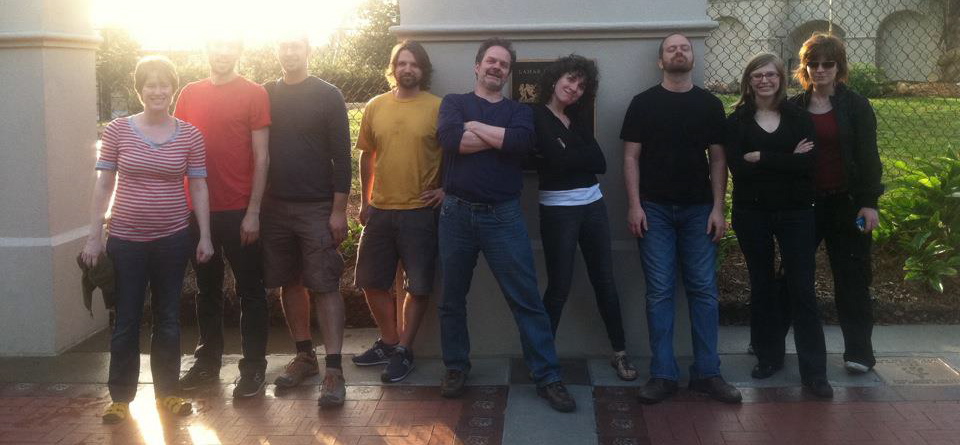
The compositional process for this project is something quite new for me. It goes something like this: I sit down with performers and talk to them about their musical lives, their education, their thoughts on just about anything we happen to think of (sometimes Saturday morning cartoons, sometimes mohair sweaters), and then I stitch together bits of those conversations into a collaged tape track that plays while they tackle a scored piece I write out for them that is largely inspired by the sound and content of what we’ve discussed. For some pieces I’m most inspired by the quality of a person’s voice (I was with Kip Jones in my portrait piece for ETHEL), for some pieces I’m most inspired by specific themes in our conversation (for Kathleen Supove I focused most on her fascination with Debussy), and for a few pieces, I take my prior friendship with the commissioner as a huge inspiration for the way in which I want to present their nature to an audience (as in my piece for longtime friend, James Moore).
The scores for these portrait pieces sometimes slavishly follow the specific timing of the tape part (thought never yet with click track), and sometimes allow for the live performing aspect to be free and gently overlaid above the electronics. It’s a heap of work for all concerned, but I’ve been loving doing it and imagine that this line of endeavor will assume a huge swath of my compositional life to come.
WALO’s inspiration:
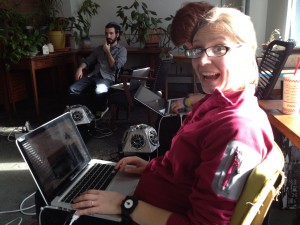 For my portrait of PLOrk and Sideband, my largest inspiration was simply that I love the crazy people I was writing for (my band!) and wanted to share that love with an audience (kind of like telling a story over dinner or around a fire). A huge part of my life as a composition grad student at Princeton was happily determined by the culture of PLOrk (the Princeton Laptop Orchestra) and the playful comradery in the music tech community over there. I hadn’t delved much into technology before starting at Princeton, and had the usual insecurities many have entering that scene, but everyone was so encouraging and inviting, I just had to give it a try! I remember Paul Lansky once told me that he got into electronic music for the community – and boy I can understand! Throwing code around an email chain at 2am with lots of expletives, having rehearsals that begin with an of an hour of giggling through quitting and restarting applications and computers both, eating pizza on dirty floors while giant files get merrily passed around on a USB key – this is the stuff of my Sideband, and I wanted to show that stuff in this piece while giving listeners a bit of the history of PLOrk, and by extension Sideband.
For my portrait of PLOrk and Sideband, my largest inspiration was simply that I love the crazy people I was writing for (my band!) and wanted to share that love with an audience (kind of like telling a story over dinner or around a fire). A huge part of my life as a composition grad student at Princeton was happily determined by the culture of PLOrk (the Princeton Laptop Orchestra) and the playful comradery in the music tech community over there. I hadn’t delved much into technology before starting at Princeton, and had the usual insecurities many have entering that scene, but everyone was so encouraging and inviting, I just had to give it a try! I remember Paul Lansky once told me that he got into electronic music for the community – and boy I can understand! Throwing code around an email chain at 2am with lots of expletives, having rehearsals that begin with an of an hour of giggling through quitting and restarting applications and computers both, eating pizza on dirty floors while giant files get merrily passed around on a USB key – this is the stuff of my Sideband, and I wanted to show that stuff in this piece while giving listeners a bit of the history of PLOrk, and by extension Sideband.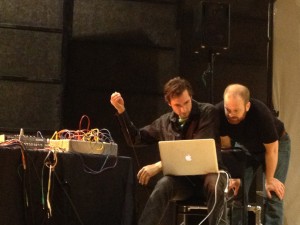
How it works:
The coding for this piece was very straightforward once I had a firm concept of the physical gesture I wanted us to be using. I quickly decided to use the tether instruments (we sure do love our tethers!), and the theatricaility of a slow, labored pull from start to finished struck a chord with my minimalist heart. For a geeky band of composers, we’re actually not bad at holding tension on stage – one of my most prized qualities in a performing ensemble. To achieve something just in the middle of music and documentary, I added the smallest of traditionally musical elements – Rebecca Fiebrink and I were the “bell-tollers” – we rang the sound I created for us by accessing the X-Y position sensor of the tethers in a synchronous motion. The rest of the gang, each performing the part of a single recorded voice, triggers each new snippet of speech by passing a threshold on the tether’s Z axis. The individual voices, the folks I interviewed, were: Perry Cook, Rebecca Fiebrink, Anne Hege, Jascha Narveson, Dan Trueman, Scott Smallwood, and Ge Wang. So each hemi speaker on stage will either be “tolling a bell” or emitting the comments of one single founder of the PLOrk/Sideband culture.
In MaxMSP, this was a trivial bit of coding to achieve, which somehow made me believe the piece would be easy to perform. Nay, not so! The length of the string on these tether controllers, it turns out, had to be subdivided to a fine enough degree (to include triggers for all of my recorded excerpts) that having the needed precision of string-tugging required remarkable virtuosity (every entrance is scored out in something like a stage script). It was fun realizing how even though this was a coded piece, the physical constraint of the instrument was still a large limiting factor.
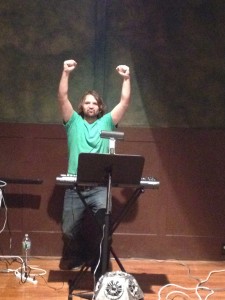
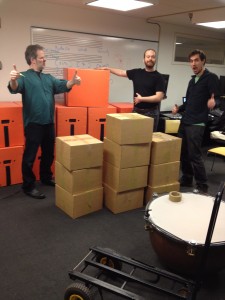 Also dizzyingly fun were the confusing conversations that occurred like “Dan, you have to have more space between gestures… no wait, not actual Dan, I mean virtual Dan… Ariane-Dan… wait, who’s Dan?” which likewise contributed to the oodles of practice time this piece required. For that time the gang put into WALO, I am forever grateful to the beautiful wacky members of Sideband who inspire me to learn and play and grow in the music tech community I love.
Also dizzyingly fun were the confusing conversations that occurred like “Dan, you have to have more space between gestures… no wait, not actual Dan, I mean virtual Dan… Ariane-Dan… wait, who’s Dan?” which likewise contributed to the oodles of practice time this piece required. For that time the gang put into WALO, I am forever grateful to the beautiful wacky members of Sideband who inspire me to learn and play and grow in the music tech community I love.
PS. A freshly baked oatmeal chocolate chip cookie to the person who identifies the origin of the title!
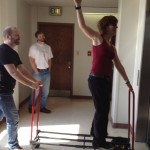
Deprecated: Function get_magic_quotes_gpc() is deprecated in /hermes/bosnacweb01/bosnacweb01aj/b676/nf.jaschanarveson/public_html/sidebandchronicles/wp-includes/formatting.php on line 4358
Deprecated: Function get_magic_quotes_gpc() is deprecated in /hermes/bosnacweb01/bosnacweb01aj/b676/nf.jaschanarveson/public_html/sidebandchronicles/wp-includes/formatting.php on line 4358
Deprecated: Function get_magic_quotes_gpc() is deprecated in /hermes/bosnacweb01/bosnacweb01aj/b676/nf.jaschanarveson/public_html/sidebandchronicles/wp-includes/formatting.php on line 4358
Deprecated: Function get_magic_quotes_gpc() is deprecated in /hermes/bosnacweb01/bosnacweb01aj/b676/nf.jaschanarveson/public_html/sidebandchronicles/wp-includes/formatting.php on line 4358
Deprecated: Function get_magic_quotes_gpc() is deprecated in /hermes/bosnacweb01/bosnacweb01aj/b676/nf.jaschanarveson/public_html/sidebandchronicles/wp-includes/formatting.php on line 4358
Deprecated: Function get_magic_quotes_gpc() is deprecated in /hermes/bosnacweb01/bosnacweb01aj/b676/nf.jaschanarveson/public_html/sidebandchronicles/wp-includes/formatting.php on line 4358
Deprecated: Function get_magic_quotes_gpc() is deprecated in /hermes/bosnacweb01/bosnacweb01aj/b676/nf.jaschanarveson/public_html/sidebandchronicles/wp-includes/formatting.php on line 4358
Deprecated: Function get_magic_quotes_gpc() is deprecated in /hermes/bosnacweb01/bosnacweb01aj/b676/nf.jaschanarveson/public_html/sidebandchronicles/wp-includes/formatting.php on line 4358
Deprecated: Function get_magic_quotes_gpc() is deprecated in /hermes/bosnacweb01/bosnacweb01aj/b676/nf.jaschanarveson/public_html/sidebandchronicles/wp-includes/formatting.php on line 4358